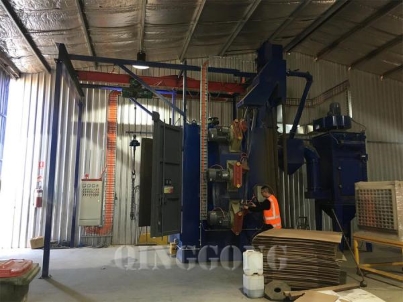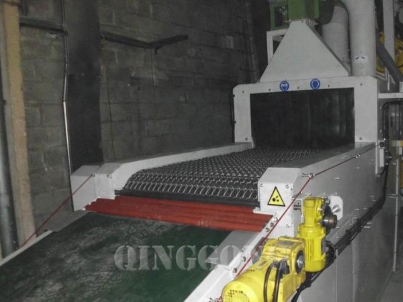Introduction to Surface Treatment Process-Metal Shot Blasting
The principle of metal shot blasting is to use an electric motor to drive the impeller body to rotate (direct drive or drive with a V-belt), and then use the action of centrifugal force to throw a projectile (including cast steel shot, steel wire cut shot, stainless steel shot) with a diameter of about 0.2 to 3.0 toward the surface of the workpiece to make the surface of the workpiece reach a certain toughness and make the workpiece beautiful. Or by changing the welding tensile stress of the workpiece to a compressive stress, the service life of the workpiece is increased. By increasing the roughness of the surface of the workpiece, the adhesion of the paint film of the subsequent painting of the workpiece is also improved. The implication is that the metal shot blasting process can be the previous process of the painting process.
Sandblasting
Sand blasting uses compressed air as the power to form a high-speed jet beam to spray the spray material (copper ore sand, quartz sand, emery sand, iron sand, Hainan sand) to the surface of the workpiece to be processed at high speed, so that the appearance or shape of the outer surface of the workpiece changes. Due to the impact and cutting effect of the abrasive on the surface of the workpiece, the surface of the workpiece is given a certain degree of cleanliness and different roughness, and the mechanical properties of the surface of the workpiece are improved. Therefore, the fatigue resistance of the workpiece is improved, the adhesion between it and the coating is increased, the durability of the coating film is extended, and it is also beneficial to the leveling and decoration of the coating.
Compared with other cleaning processes (such as pickling and tool cleaning), the sandblasting process has the following characteristics:
1. Sand blasting is the most thorough, versatile, fastest and most efficient cleaning method.
2. Sandblasting treatment can be chosen arbitrarily between different roughness. There is no way for other processes to achieve this. Hand sanding can create a rough surface but the speed is too slow. Chemical solvent cleaning makes the surface clean too smooth, which is not conducive to coating bonding.
Peening characteristics
1. Great flexibility in cleaning
It is easy to clean the inner and outer surfaces of complex workpieces and the inner wall of pipe fittings. It is not limited by the site, and it can be moved to the vicinity of extra large workpieces for cleaning.
2. The equipment structure is simple, the investment of the whole machine is small, the wearing parts are few, and the maintenance cost is low.
3. High energy consumption
It must be equipped with a high-power air compressor station.
4. Cleaning the surface is prone to moisture and easy to embroider.
5. The cleaning efficiency is low, there are many operators, and the labor intensity is large.
Characteristics of metal shot blasting
1. Poor flexibility
Due to the limitation of the site, the cleaning of the workpiece is somewhat blind, and it is easy to produce dead corners on the inner surface of the workpiece that cannot be cleaned.
2. There is no need to accelerate projectiles with compressed air, and there is no need to set up a high-power air compressor station.
3. Cleaning the surface is not easy to have moisture, and it is not easy to embroider.
4. The equipment structure is relatively complicated, and there are many wearing parts, especially the blades and other parts. There are many maintenance hours and high cost.
5. The cleaning efficiency is high, the cost is low, the operator is few, and it is easy to realize automatic control. It is suitable for mass production.
Shot peening
The surface treatment with shot blasting has a strong impact force and a clear cleaning effect. However, shot peening of thin-plate workpieces is easy to deform the workpiece, and the steel shot hits the surface of the workpiece (regardless of metal shot blasting or shot peening) to deform the metal substrate. Since Fe3O4 and Fe2O3 have no plasticity, they are peeled off after crushing. The oil film deforms together with the base material, so metal blasting and shot blasting cannot completely remove the oil stains on the workpieces with oil stains. Among existing workpiece surface treatment methods, the best cleaning effect is sandblasting. Sand blasting is suitable for the cleaning of workpieces with high requirements. However, the current domestic general blasting equipment is mostly made up of primitive bulky sand conveying machinery such as hinged dragon, scraper, bucket elevator.
The difference between shot peening and metal shot blasting
Shot blasting uses high-pressure wind or compressed air as power, and metal shot blasting is generally a high-speed rotating flywheel that ejects steel sand at high speed. The metal shot blasting efficiency is high, but there will be dead ends, and the shot blasting is more flexible, but the power consumption is large.
Although the jet power and method of the two processes are different, they are aimed at impacting the workpiece at high speed. The effect is basically the same. In contrast, shot peening is relatively fine, easy to control accuracy, but the efficiency is not as high as metal shot blasting, suitable for small workpieces with complex shapes. Metal shot blasting is more economical and practical. It is easy to control the efficiency and cost. The particle size of the shot can be controlled to control the spraying effect, but there will be a dead end. It is suitable for batch processing of workpieces with a single surface.
The choice of the two processes mainly depends on the shape and processing efficiency of the workpiece.
The difference between shot blasting and sand blasting
Both shot blasting and sand blasting use high-pressure wind or compressed air as the power, blowing it out at high speed to impact the surface of the workpiece to achieve the cleaning effect. The selected medium is different, and the effect is also different.
After sandblasting, the dirt on the surface of the workpiece is removed, the surface of the workpiece is damaged in a small amount, and the surface area is greatly increased. Thus, the bonding strength between the workpiece and the coating/plating layer is increased.
The surface of the workpiece after sandblasting is metallic, but because the surface is rough, the light is refracted, so there is no metallic luster and it is a dark surface.
After shot peening, the dirt on the surface of the workpiece was removed, the surface of the workpiece was traced without being destroyed, and the surface area increased. Since the surface of the workpiece is not damaged during processing, the excess energy generated during processing will induce the surface strengthening of the workpiece base.
The surface of the workpiece after shot peening is also metallic in nature. However, because the surface is spherical, part of the light is refracted, so the workpiece is processed into a matte effect.
 EN
EN
 fr
fr  de
de  es
es  it
it  ru
ru  pt
pt  ar
ar  th
th  pl
pl  ro
ro 


